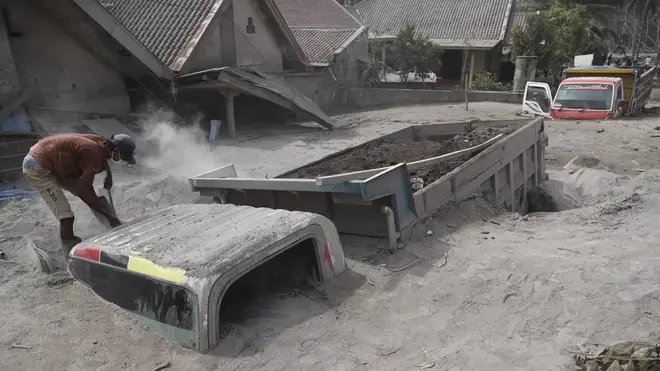
Ian Payne 4am - 7am
5 December 2021, 13:54

Several villages were blanketed with falling ash.
Rescuers were sifting through smouldering debris and thick mud in search of survivors a day after the highest volcano on Indonesia’s most densely populated island of Java erupted, killing at least 14 people.
Mount Semeru in Lumajang district in East Java province spewed thick columns of ash more than 12,000 metres (40,000 feet) into the sky in a sudden eruption on Saturday triggered by heavy rains.
Villages and nearby towns were blanketed and several hamlets buried under tons of mud from volcanic debris.
Flows of hot gas and lava travelled up to 6.8 miles (11km) to a nearby river at least twice on Saturday and three times on Sunday with a smaller distance of up to one-and-a-half miles (2km), according to Indonesia’s Volcanology and Geological Hazard Mitigation Agency.
Authorities warned the thousands of people who fled the volcanic eruption not to return during Sunday’s lull in activity. But some were desperate to check on livestock and possessions left behind. In several areas, everything – from the thinnest tree branch to couches and chairs inside homes – was caked with ash.
“There’s no life there … trees, farms, houses are scorched, everything is covered in heavy grey ash,” Haryadi Purnomo, of East Java’s search and rescue agency, said.
He said that several other areas were virtually untouched.

Search and rescue efforts were temporarily suspended on Sunday afternoon because of fears that hot ash and debris could tumble down from the crater due to heavy rains.
On Saturday, a torrent of mud destroyed the main bridge connecting Lumajang and the neighbouring district of Malang, as well as a smaller bridge, Thoriqul Haq, the district chief in Lumajang, said.
The eruption eased pressure that had been building under a lava dome perched on the crater. But experts warned that the dome could collapse further, causing an avalanche of the blistering gas and debris trapped beneath it.
A thunderstorm and days of rain, which eroded and partly collapsed the dome on top of the 3,676-metre (12,060-foot) Semeru, triggered the eruption, Eko Budi Lelono, who heads the geological survey centre, said.

Semeru is also known as Mahameru, meaning The Great Mountain in Sanskrit.
It has erupted many times over the last 200 years. Still, as with other volcanoes – it is one of 129 under watch in Indonesia, the world’s largest archipelago – more than 62,000 people call Sumeru’s fertile slopes home. It last erupted in January, with no casualties.
Indonesia, an archipelago of more than 270 million people, is prone to earthquakes and volcanic activity because it sits along the Pacific Ring Of Fire, a horseshoe-shaped series of fault lines.
Some 54% of the country’s population live on Java, the country’s most densely populated area.

Officials said earlier they had hoped they could avoid casualties by closely monitoring the volcano.
National Disaster Mitigation Agency spokesperson Abdul Muhari said 56 people had been hospitalised, mostly with burns injuries. He said rescuers were still searching for nine residents of Curah Kobokan village.
More than 900 villagers streamed into makeshift emergency shelters after Saturday’s powerful eruption, but many others defied official warnings and chose to remain in their homes, saying they had to tend to their livestock and protect their property, Mr Purnomo said.
“We’ll do everything we can to evacuate them by preparing trucks and motorbikes for them to flee at any time,” he said.
Indonesian president Joko Widodo said he had instructed his cabinet ministers and disaster and military officials to co-ordinate the response.